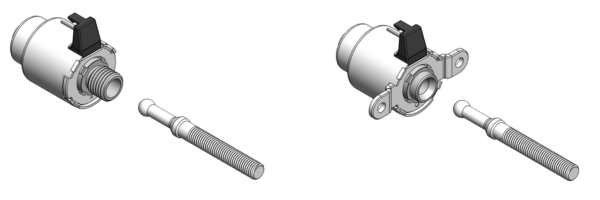The Challenge:
Engineers often desire a device which can provide an electrically actuated, high-force locking function.
Quickly, they run into challenges finding a locking solenoid that will provide the force needed, in a reasonable size, as well as one which can operate within the constraints of their system’s power supply.
They also face many challenges when designing an effective locking solenoid assembly, one which can provide thousands of reliable locking actions, as well as produce the higher hold-forces needed for extreme security applications.
The high cost of assembling and aligning such solenoid latching mechanisms into the overall “system” can also have a negative impact on overall system viability (from both a reliability perspective, as well as cost).

The Solution:
Magnet-Schultz of America has developed a new family of Ball-Detent Solenoid products which can:
- mitigate both the solenoid size and power concerns
- provide locking forces that exceed 200 pounds
- significantly cost reduce the assembly process in the customer’s overall system
- insure superior reliability
- reduce complexity by reducing the number of parts required
This new product line evolved from MSA’S Ball-Detent technology (patent application No. 14592511), the operation of which is described in detail in MSA’s BLOG titled: “BDL Series: Part Two, Ball-Detent Solenoids”.
The advantage of this unique technology is the “Ball” feature, located on the end of a threaded shaft, which works in conjunction with the solenoid’s internal mechanisms to provide a secure locking function.
This new family of products provides a 200+ lb locking force, without the need to continuously apply any electrical power to the device.
Furthermore, these new Ball-Detent Solenoids require little of the system designer other than to provide a secure mounting position for the solenoid body on one side of the “system”, and an internal thread to hold the Ball-Shaft on the “mating” side of the system. Eliminating the need for the design effort required to mate a complex latching mechanism with a conventional solenoid saves time, reduces manufacturing cost, and improves time-to-market.

This new Locking Solenoid Family comes in two versions:
1. Standard Release Energy, Purely Electro-Mechanical Solution:
With this member of the Ball-Detent Solenoid family, inserting the Ball-Shaft into the solenoid mechanism simultaneously displaces a locking ring. Three internal locking balls then surround and press against the Ball-Shaft, making it impossible to withdraw the Shaft from the solenoid body, thereby creating the locking function. The locking ring is kept in place via an internal spring mechanism.
When one desires to unlock the system, the coil of this solenoid requires a 25 Watt pulse of energy, for 100 ms, to enable the internal spring to eject the Ball-Shaft, thereby unlocking the overall system.
Specifications (In Accordance with DIN VDE 0580 Specifications):
- Coil Voltage: 12 VDC, or 24 VDC`
- Coil Power Rating: 25 Watts
- Duty Cycle: Pulse
- Static Load: 200 lbs (890 Newtons, 90 kg)
- Dynamic Load: .9 lbs (4 Newtons, .4 kg)
2. Energy Saving, Internal Permanent Magnet Solution:
Just as with the Higher Release Energy, Electro-Mechanical version described above, inserting a Ball-Shaft into this solenoid mechanism simultaneously displaces a locking ring, allowing three internal locking balls to surround and press against the Ball-Shaft. The pressure of the locking balls against the Ball-Shaft prevents withdrawal of the Shaft from the solenoid, thus creating the locking function. However, with the Low Release Energy device, the locking ring is kept in place via a permanent magnet.
When one desires to unlock this solenoid, the coil requires only a 10 Watt pulse of energy, for 100 ms, to nullify the hold of the permanent magnet. This action enables an internal spring to displace the Ball-Shaft, thereby unlocking both the solenoid and the overall system.
Specifications:
- Solenoid:
- Diameter: 1” (25.4 mm)
- Overall Length: 1.47” (37.3 mm)
- Electrical Connection: Integrated, two pin, snap-lock Molex 2695 Series Connector
- Ball-Shaft:
- Ball Diameter: .25” (6.3mm)
- In Accordance with DIN VDE 0580 Specifications:
- Coil Voltage: 12 VDC, or 24 VDC
- Coil Power Rating: 10 Watts
- Duty Cycle: 10%, 1 minute maximum on-time
- Static Load: 200 lbs (890 Newtons, 90 kg)
- Dynamic Load: 10 lbs (4 Newtons, .4 kg)
Manual Override:
Both Ball-Detent Solenoids described above can incorporate a “manual over-ride” safety feature, which allows one to mechanically unlock the system, in the event of a power failure or the like.
Comparison of the Ball-Detent Locking Solenoids with a Conventional Solenoid:
A conventional solenoid would be 3 times larger, and could require as much as 100 watts of input power to effect the same locking force as either of the Ball-Detent designs.
It would also have to be mated with a far more elaborate and costly latch mechanism.
Summary:
Both Ball-Detent Solenoids described above require lower input energy, provide superior locking force, and simplify the overall locking mechanism for any new system.
The Lower Release Energy version can be especially useful for energy sensitive battery powered systems.
Please feel free to contact MSA to obtain answers to any questions you may have, and for help designing these unique products into your new system.







Leave A Comment